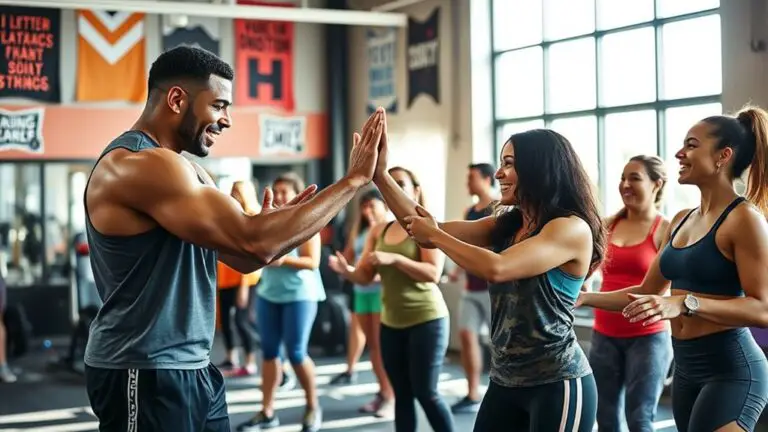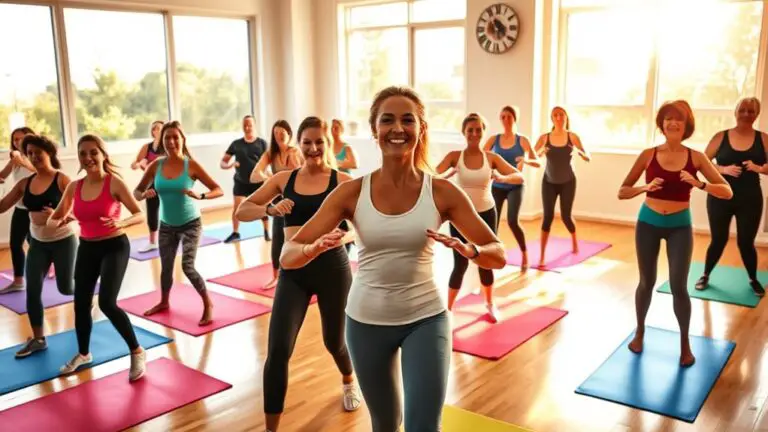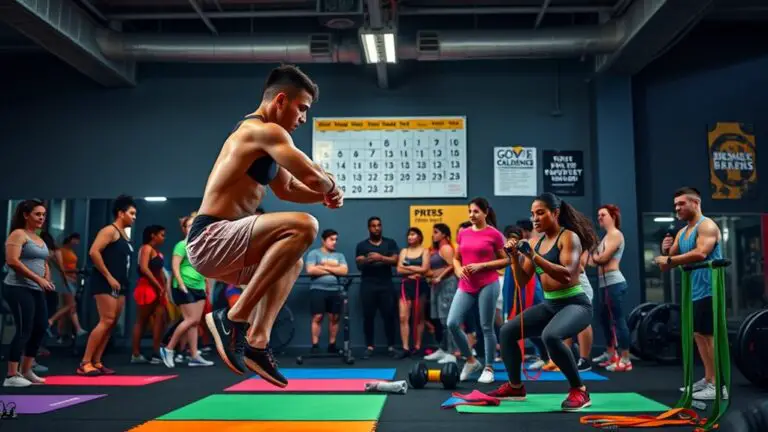How to Use Meditation for Better Workout Performance

To boost your workout performance with meditation, focus on techniques like mindfulness and visualization. These practices enhance clarity and resilience, helping you push through physical challenges. Start by establishing a consistent meditation routine, even a few minutes daily can elevate your mental game. Incorporate focused breathing to optimize your energy levels during workouts. Celebrate small victories and track your progress. This approach will not only improve your fitness but also open doors to deeper insights and benefits ahead.
Understanding the Connection Between Meditation and Physical Performance

While many athletes focus solely on physical training, understanding the connection between meditation and physical performance can elevate your workouts to new heights. Meditation isn’t just a calming practice; it’s a powerful tool for enhancing mental clarity and improving your overall performance. By regularly incorporating meditation into your routine, you can train your mind to stay focused, helping you push through physical challenges with greater ease.
Additionally, meditation promotes stress reduction, which is essential for peak performance. When you manage stress effectively, you’re less likely to experience burnout or anxiety, allowing you to maintain a consistent training schedule. This mental resilience can lead to improved endurance and quicker recovery times.
Types of Meditation Beneficial for Athletes
To enhance your athletic performance, exploring different types of meditation can be a game-changer. Mindfulness meditation techniques help you stay present and focused, while visualization can supercharge your motivation and execution. Let’s look at how these practices can elevate your workout routine.
Mindfulness Meditation Techniques
Mindfulness meditation techniques can greatly enhance athletic performance by fostering focus and resilience. One effective method is mindful breathing, where you concentrate on your breath to anchor your thoughts. This practice not only calms your mind but also sharpens your focus during workouts. Another technique is developing body awareness, which involves tuning into your body’s sensations and movements. This heightened awareness helps you recognize fatigue, pain, or tension, allowing you to adjust your efforts accordingly. Incorporating these techniques into your routine can lead to improved concentration, making it easier to push through challenging workouts. Try setting aside a few minutes each day for mindful breathing and body awareness exercises to see significant changes in your performance.
Visualization for Performance Boost
Visualization can be a powerful tool for athletes looking to enhance their performance, as it allows you to mentally rehearse your goals and improve your focus. By incorporating guided imagery into your training, you can visualize success and create a mental blueprint for your workouts. This technique helps reduce anxiety and boosts your confidence.
Here’s a simple breakdown of visualization techniques:
| Technique | Description | Benefits |
|---|---|---|
| Guided Imagery | Listening to a script or recording | Enhances relaxation and focus |
| Mental Rehearsal | Practicing movements in your mind | Improves muscle memory |
| Performance Visualization | Envisioning successful outcomes | Increases motivation and confidence |
| Relaxation Techniques | Deep breathing and calming visuals | Reduces stress and tension |
| Goal Visualization | Imagining achieving your goals | Clarifies objectives and intentions |
Setting Up a Meditation Routine
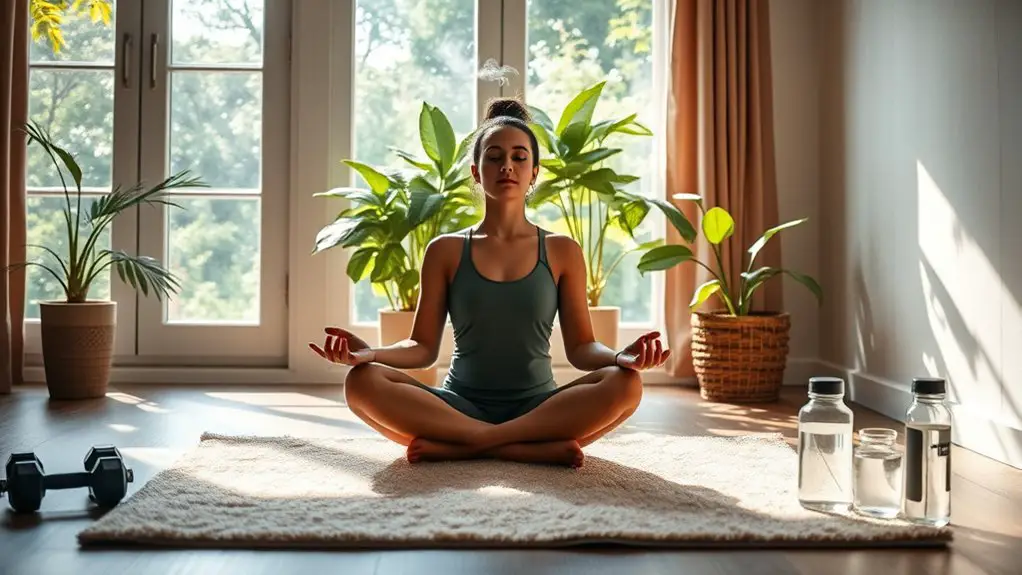
To set up an effective meditation routine, start by choosing a quiet space where you can focus without distractions. Next, establish a consistent schedule that fits your lifestyle, making it easier to commit to your practice. Finally, begin with short sessions to gradually build your comfort and confidence.
Choose a Quiet Space
While finding a quiet space might seem simple, it’s vital for setting up an effective meditation routine that enhances your workout performance. A calm environment allows you to focus and center your thoughts, which is essential for maximizing the benefits of meditation. Consider your personal preferences when selecting the space.
- Choose a spot away from noise and distractions.
- Make sure it feels comfortable and safe for you.
- Experiment with different locations to find what works best.
- Add elements you love, like soft lighting or calming scents.
Set a Schedule
Establishing a consistent meditation schedule can greatly enhance your workout performance. By dedicating specific times each week for meditation, you’ll create a routine that fosters the meditation benefits you seek. Aim for a balance that complements your workout regimen; this creates workout synergy, allowing both practices to elevate each other. Consider aligning your meditation sessions with your training days for maximum effect. Whether it’s early in the morning or right after a workout, find what works best for you. Consistency is key—making it a habit guarantees that you reap the rewards, such as improved focus, reduced stress, and increased stamina. Stick to your schedule, and you’ll notice how meditation transforms your overall workout experience.
Start With Short Sessions
Starting with short meditation sessions can make a significant difference as you set up your routine. As a beginner, it’s essential to ease into meditation to build consistency and comfort. Here are some beginner tips for those short sessions:
- Start with 5-10 minutes: This is manageable and less intimidating.
- Choose a quiet space: Minimize distractions to help you focus.
- Focus on your breath: This simple technique can ground you and enhance mindfulness.
- Gradually increase duration: As you grow more comfortable, extend your sessions.
Breathing Techniques to Enhance Focus
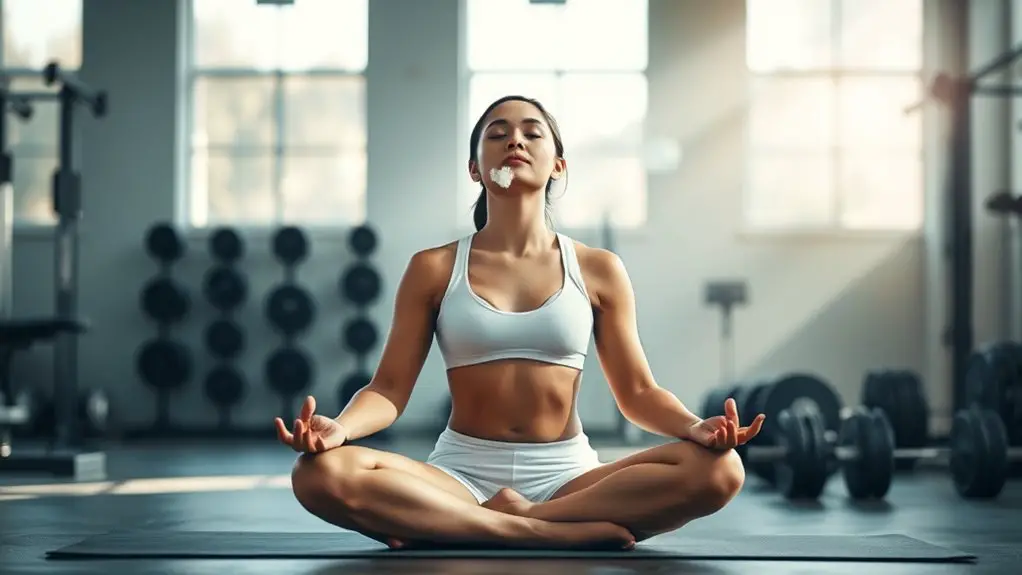
To truly release your workout potential, mastering specific breathing techniques can greatly enhance your focus and performance. By practicing breath awareness, you’ll learn to control your breath and maintain concentration during intense workouts. Start with focused breathing—inhale deeply through your nose, filling your lungs completely, and exhale slowly through your mouth. This rhythm not only calms your mind but also optimizes oxygen flow to your muscles.
Incorporate breath counts during your exercises. For instance, inhale for four counts, hold for four, then exhale for six. This method improves focus and helps maintain energy levels. As you build this habit, you’ll find that your workouts become more efficient. Remember, every breath counts; it’s your anchor in moments of fatigue. By honing these techniques, you’ll enhance not just your physical performance but also your mental clarity, paving the way for a more fulfilling workout experience.
Visualization for Performance Improvement
Building on your newfound focus from breathing techniques, visualization can be a powerful tool to elevate your workout performance. By incorporating mental imagery into your routine, you can enhance motivation, refine skills, and improve overall results.
Consider these effective visualization techniques:
- Imagine Success: Picture yourself achieving your fitness goals, whether it’s lifting heavier weights or completing a marathon.
- Detailed Scenarios: Visualize every step of your workout, from warm-up to cool-down, to mentally prepare for each phase.
- Positive Reinforcement: Use mental imagery to reinforce self-confidence, picturing yourself overcoming challenges during tough workouts.
- Emotional Connection: Feel the emotions associated with your achievements, creating a strong motivation to push through.
Mindfulness Practices During Workouts
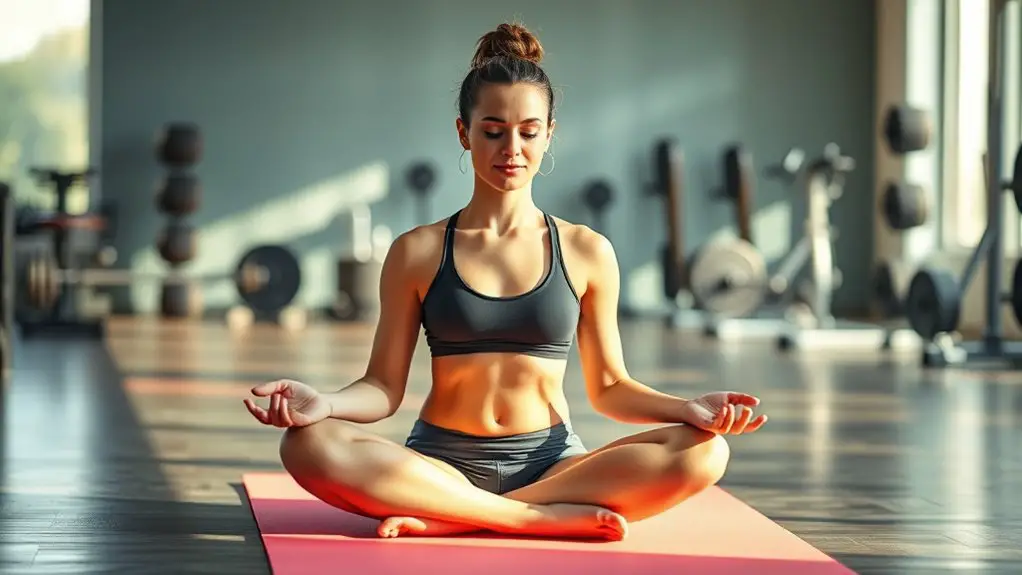
While you push through your workouts, incorporating mindfulness practices can greatly enhance your experience and performance. One effective technique is mindful stretching. Instead of rushing through your stretches, take a moment to focus on each muscle group. Feel the tension release as you breathe deeply, allowing your body to relax and rejuvenate.
Integrating breath awareness during your exercises can also elevate your workout. Pay attention to your breath as you move. Inhale deeply during the exertion and exhale fully as you release. This connection not only keeps you grounded but also helps maintain your energy levels.
Recovery and Meditation: Enhancing Muscle Repair
After a workout, the role of recovery becomes paramount, and meditation can be a powerful ally in this process. By incorporating meditation into your recovery routine, you not only enhance muscle regeneration but also promote stress reduction, which is essential for peak performance.
Incorporating meditation into your recovery routine enhances muscle regeneration and reduces stress for optimal performance.
Here are a few ways meditation can help:
- Improved Blood Flow: Meditation encourages relaxation, increasing blood circulation to your muscles.
- Reduced Cortisol Levels: Lower stress levels mean less cortisol, allowing your body to focus on recovery.
- Enhanced Mind-Body Connection: Meditation helps you tune into your body, recognizing areas that need attention.
- Support for Emotional Well-being: A positive mindset contributes to a more effective recovery journey.
Measuring the Impact of Meditation on Your Fitness Goals
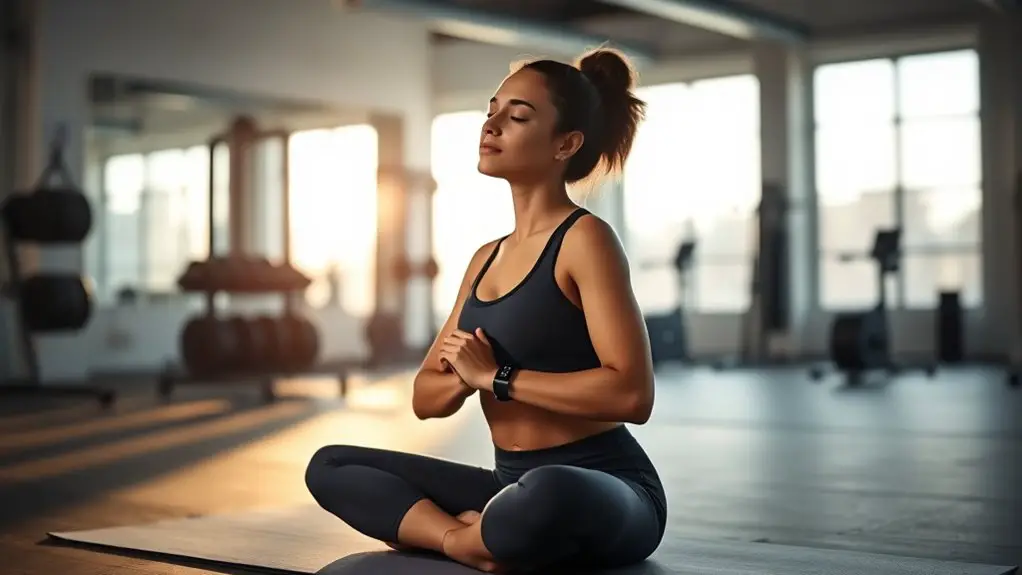
As you integrate meditation into your fitness routine, tracking its impact on your goals can be both enlightening and motivating. Start with an impact assessment to identify specific areas where meditation influences your performance, such as focus, endurance, or recovery. Keep a journal to note physical and mental changes, linking them to your meditation practices. This goal tracking will help you see patterns and improvements over time.
Consider using apps or wearable devices that monitor your workout performance alongside your meditation sessions. By comparing your progress, you’ll gain insights into how meditation enhances your overall fitness journey. Celebrate small victories, whether it’s running faster, lifting heavier, or feeling more centered during workouts. Remember, measuring the impact isn’t just about numbers; it’s about recognizing the mental clarity and emotional resilience that meditation brings, which ultimately drives you closer to your fitness aspirations.
Tips for Staying Consistent With Your Meditation Practice
Staying consistent with your meditation practice is key to reaping its benefits for workout performance. To help you maintain this consistency, consider implementing these motivation strategies:
- Set a specific time: Choose a time that works best for you each day to meditate, making it a non-negotiable part of your routine.
- Start small: Begin with just a few minutes daily and gradually increase the duration as you become more comfortable.
- Use guided sessions: Leverage apps or online resources to keep you engaged and focused during your practice.
- Find accountability partners: Share your goals with friends or join a meditation group to guarantee you’re supported and encouraged.
Frequently Asked Questions
Can Beginners Meditate Effectively for Workout Performance Improvement?
Absolutely, beginners can meditate effectively to improve workout performance! While you might face some beginner challenges like maintaining focus, starting with simple meditation techniques can make a big difference. Try guided sessions or focusing on your breath for just a few minutes daily. As you progress, you’ll find it easier to integrate meditation into your routine, enhancing mental clarity and resilience. Stick with it, and you’ll see the benefits unfold in your workouts!
How Long Should I Meditate for Optimal Results?
To achieve ideal results, aim for a meditation duration of 10 to 20 minutes per session. This timeframe allows your mind to settle and focus without feeling overwhelming. You might find that consistency is key; try to meditate daily, even if it’s just for a short period. As you progress, you can gradually increase your session length. Remember, it’s about quality, not just quantity, so stay present and engaged during each session.
What Time of Day Is Best for Meditation?
When it comes to the best time for meditation, consider morning benefits and evening relaxation. Meditating in the morning can set a positive tone for your day, helping you focus and find clarity. On the other hand, evening sessions can help you unwind, releasing the day’s stress and promoting restful sleep. Ultimately, it’s about what fits your schedule and lifestyle. Experiment with both times to discover when you feel most centered and rejuvenated.
Can Meditation Replace Physical Warm-Ups or Cool-Downs?
Meditation can’t fully replace physical warm-ups or cool-downs, but it can enhance your mind-body connection and mental focus. While physical movements prepare your body for exercise and help it recover afterward, meditation can prime your mind, allowing you to engage more fully in your workout. Incorporating meditation into your routine can boost your overall performance, but don’t skip those physical aspects—combine both for the best results!
Are There Specific Apps for Meditation Tailored to Athletes?
You know how athletes swear by their “secret sauce”? Well, specific meditation apps can be that game-changer for you. These apps offer tailored meditation techniques designed to enhance your athlete focus, helping you stay in the zone during workouts. Look for features like guided sessions or breath control exercises. By incorporating these into your routine, you’ll not only boost your mental clarity but also elevate your overall performance. Why not give them a try?
